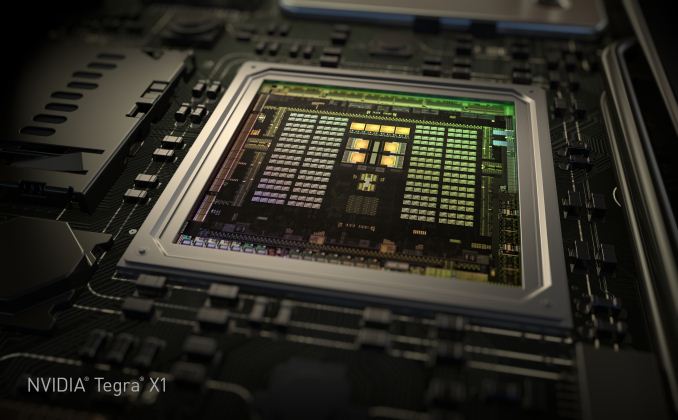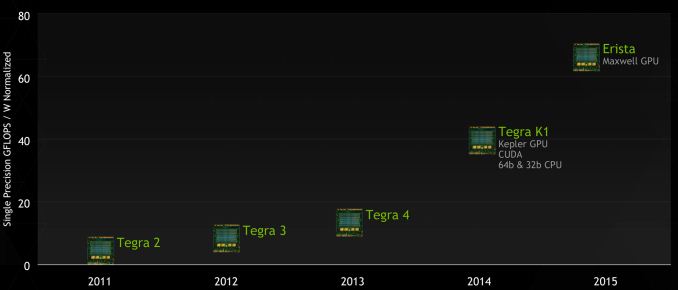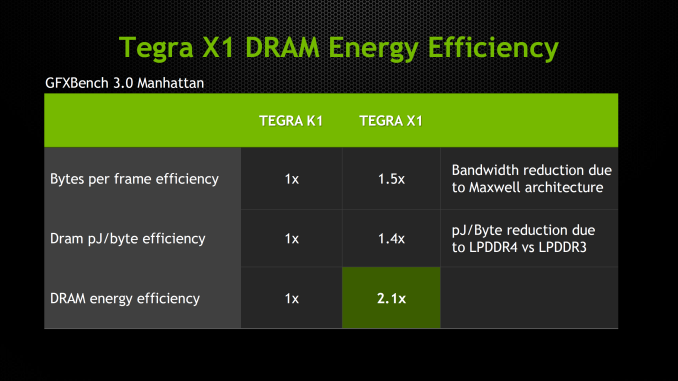NVIDIA Tegra X1 Preview & Architecture Analysis
by Joshua Ho & Ryan Smith on January 5, 2015 1:00 AM EST- Posted in
- SoCs
- Arm
- Project Denver
- Mobile
- 20nm
- GPUs
- Tablets
- NVIDIA
- Cortex A57
- Tegra X1

In the past few years, we’ve seen NVIDIA shift their mobile strategy dramatically with time. With Tegra 2 and 3, we saw multiple design wins in the smartphone space, along with the tablet space. These SoCs often had dedicated GPUs that were quite unlike what we saw in NVIDIA’s desktop and laptop GPUs, with a reduced feature set and unique architecture. However, with Tegra K1 we saw a distinct shift in NVIDIA’s SoC strategy, as the Tegra K1 was the first mobile SoC to achieve parity in GPU architecture with desktop GPUs. In the case of the Tegra K1, this meant a single Kepler SMX which made for truly incredible GPU performance. However, in the time since we’ve seen companies like Apple release new SoCs such as the A8X, which managed to bring largely similar performance with less power.
NVIDIA of course is never content to stay idle for too long and let themselves be surpassed, which has led to the company developing their Tegra SoCs on a roughly yearly cadence. In NVIDIA’s development timeline, 2014 brought us the Tegra K1-32, the company’s first SoC to integrate a modern high-performance GPU architecture (Kepler), and later on the TK1-64, a K1 with NVIDIA’s own in-house developed ARMv8 Denver CPU in place of the 32bit ARM A15 CPU.

NVIDIA's GTC 2014 Tegra Roadmap
2014 also brought a revision to NVIDIA’s public Tegra roadmap: for 2015 NVIDIA would bump the previously announced Parker SoC and release a new in its place, Erista. This schedule change ended up being quite a surprise due to the fact that NVIDIA had up until this time released their roadmaps roughly 2 years out, whereas Erista was put on the map less than a year before it was to be announced. More unusual, NVIDIA offered up minimal details of Erista; it would be powered by a Maxwell GPU with no additional information on the CPU or manufacturing process. Parker on the other hand – NVIDIA’s planned Denver + Maxwell + 16nm FinFet part – fell off the schedule, with NVIDIA not officially canceling it but also saying little else about it.
Now in 2015 and with the launch of the Tegra X1, we can finally begin putting the picture together. Erista as it turns out is something of a rapid release product for NVIDIA; what had been plans to produce a 16nm FF part in 2015 became plans to produce a 20nm part, with Erista to be that part. To pull together Erista NVIDIA would go for a quick time-to-market approach in SoC design, pairing up a Maxwell GPU with ARM Cortex A57 & A53 GPUs, to be produced on TSMC’s 20nm SoC process.
CPU
We’ll kick off our look at Erista then with a look at Erista’s CPUs, where one of the bigger surprises in Erista is the CPU configuration. While Tegra K1 had a version with NVIDIA’s custom Denver core for the CPU, NVIDIA has elected to use ARM’s Cortex A57 and A53 in the Tegra X1. The A57 CPU cluster has 2MB of L2 cache shared across the four cores, with 48KB/32KB L1s (I$+D$) per core. The A53 cluster has 512KB of L2 cache shared by all four cores and 32KB/32KB L1s (I$+D$) per core. NVIDIA representatives stated that this was done for time to market reasons.
However, rather than a somewhat standard big.LITTLE configuration as one might expect, NVIDIA continues to use their own unique system. This includes a custom interconnect rather than ARM’s CCI-400, and cluster migration rather than global task scheduling which exposes all eight cores to userspace applications. It’s important to note that NVIDIA’s solution is cache coherent, so this system won't suffer from the power/performance penalties that one might expect given experience with previous SoCs that use cluster migration.
Although cluster migration is usually a detriment to power and performance (especially without a cache coherent interconnect), NVIDIA claims that Tegra X1 significantly outperforms Samsung System LSI’s Exynos 5433 in performance per watt with 1.4x more performance at the same amount of power or half the power for the same performance on the CPU. It's likely that this difference comes from optimizing the implemented logic and differences between Samsung and TSMC 20nm processes rather than differences in thread management. NVIDIA continues to use System EDP (Electrical Design Point) management to control throttling and turbo rather than ARM's IPA (Intelligent Power Allocation) drivers, and in general it seems that while the CPU architecture is ARM's reference design it's quite clear that everything else is distinctly NVIDIA in design.
All of this of course raises the question of where’s Denver, and what is to happen to it? The use of the ARM Cortex A57 and A53, as NVIDIA tells it, was based on a time-to-market decision, and that NVIDIA could bring an off-the-shelf Cortex-based SoC to the market sooner than they could another Denver SoC. On the surface there is at least some evidence to agree with this, as NVIDIA would be able to buy a 20nm design from ARM versus spending the time porting Denver over from TSMC’s 28nm process to their 20nm process. At the same time however integrating an ARM CPU core into an SoC is not an easy task – logic LEGO this is not – so it’s hard to say whether this actually saved NVIDIA much time.
In any case, much like the still in the dark Parker design, NVIDIA is holding their cards close to their chest and hinting that Denver will still be in future generation products. If Parker is still part of NVIDIA’s plans – and they are without a doubt working on some kind of 16nm FF Tegra SoC – then we may still see Denver as part of the original Parker plan. Otherwise at this point while there’s no reason not to believe NVIDIA about the fate of future Denver SoCs, it’s anyone’s guess when we might see it again.
Uncore
Outside of the CPU and GPU, NVIDIA has also dramatically improved the rest of Tegra X1 in comparison with Tegra K1. We see a move from 64-bit wide LPDDR3 to 64-bit wide LPDDR4 on the memory interface, which improves peak memory bandwidth from 14.9 GB/s to 25.6 GB/s and improves power efficiency by around 40%. In addition, the maximum internal display resolution moves from 3200x2000 at 60 Hz to 3840x2160 at 60 Hz with support for VESA’s display stream compression. For external displays, we see a significant improvement with support for HDMI 2.0 and HDCP 2.2, which means that 4K60 is supported in contrast with the Tegra K1, which only supported 4K30.
The ISP is largely similar to the one we see in the Tegra K1 when it comes to feature set, but JPEG encode and decode rate is now five times as fast, going from 120 MP/s to 600 MP/s. For video encode and decode, we see support for 4K60 H.265 and VP9, with support for 10 bit color on decode on H.265. In addition to support for new codecs in the hardware blocks, we see that H.264 and VP8 now support 4K60, a notable improvement over the 4K30 that was the maximum for Tegra K1. We also see that the storage controller now supports eMMC 5.1 for faster storage performance.













194 Comments
View All Comments
Aenean144 - Monday, January 5, 2015 - link
Honestly, why? What does doing that really benefit Apple?chizow - Monday, January 5, 2015 - link
They'll gain access to better GPU IP immediately, if they are going to pay a licensing fee, might as well pay (presumably) more for better IP I suppose.From a software support standpoint, they'd gain 100% compatibility and portability with all the latest OpenGL specs, so you'd have a shared graphics platform there with their iOS platforms. Then they wouldn't have to much around with Metal and iOS API so much, which would make it easier for them to merge the two platforms as the rumors have suggested.
Aenean144 - Monday, January 5, 2015 - link
None of what you state is a material advantage to Apple.The essence of your belief is that Nvidia will have a more powerful GPU solution than what Apple can come up with their own or through ImgTec. A lot of people don't think that will be true.
On top of that, this Tegra X1 SoC does not appear suitable for phones, and moreover, Nvidia appears to be concentrating on embedded applications with higher TDP with the X1. This would pose a problem for Apple as the iPhone is currently their most important product.
chizow - Monday, January 5, 2015 - link
Not having to support two different graphics APIs, one of which is being developed from scratch, isn't a material advantage to Apple?And a lot of people don't think what Nvidia has isn't already better than what Imgtech can produce? Who are you referring to exactly? Realists already know Nvidia's last-gen Kepler is already better than PowerVR rogue. Remember when PowerVR released roadmaps and those same people expected PowerVR Rogue XT 6-core to match Tegra K1 based on paper spec FLOP counts alone? What happened in reality? Apple needed to add ANOTHER 2 cores in a custom 8-core Rogue XT configuration to trade blows with K1.
The whole point of licensing is that even if the Tegra SoC as a whole doesn't fit their needs, they can license the IP and integrate it however they like into their own SoC.....
Yojimbo - Monday, January 5, 2015 - link
He is talking about Apple licensing a GPU from NVIDIA instead of from IMG. The Tegra X1 is not a GPU, it is an SOC targeted at a specific market segment. The target of the Tegra X1 has been set by the market NVIDIA thinks it can penetrate more than by the abilities of the GPU it contains. NVIDIA was not able to penetrate the smartphone market because of a lack of a good modem option. They have since stopped trying, and this is well-known. Apple has access to a modem, so this is not a concern for them. All they need to consider is if licensing a GPU, or GPU IP, from NVIDIA helps them more than licensing from IMG. I think on the same process technology, NVIDIA's offering would be superior, no matter if used in a phone or tablet.lucam - Wednesday, January 7, 2015 - link
Really? Why NV doesn't do any product with GPU in a phone anymore?name99 - Monday, January 5, 2015 - link
Who says nV is WILLING to license? Do they license to anyone else?pSupaNova - Tuesday, January 6, 2015 - link
http://www.anandtech.com/show/7083/nvidia-to-licen...
chizow - Tuesday, January 6, 2015 - link
And they also generate roughly $266 million per year in revenue as a result of their cross-licensing agreement/settlement with Intel. That obviously makes Intel the most likely suitor as the 1st Nvidia SoC GPU IP licensee, since they already have Nvidia GPU IP in their desktop CPU IGPs but still license IMGtech IP for their mobile SoCs.But my bet is on Apple being the 1st major licensee, largely dependent on the outcome of the Samsung/Qualcomm IP litigation.
chitownbarber - Tuesday, January 6, 2015 - link
Per Samsung's track record, the legal eagles will drag things on for years to come. Not sure what Qaulcomm will do? If you think Apple is in negotiations with Nvidia, which I agree with, then they should be coming to an agreement sometime soon to give the GPU engineers Apple has hired to do their mojo? I'm sure Apple would like nothing better to leave Samsung in the dust by exploiting the advanced gaming market that they are inspiring to, along with a rumored do-all living room console.